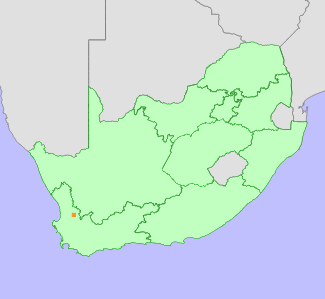|
Scientific Name | Serruria flava Meisn. |
Higher Classification | Dicotyledons |
Family | PROTEACEAE |
Common Names | Spiderhead (e), Spinnekopbos (a), Wuppertal Spiderhead (e) |
National Status |
Status and Criteria | Critically Endangered B1ab(ii,iii,v) |
Assessment Date | 2020/06/16 |
Assessor(s) | A.G. Rebelo & D. Raimondo |
Justification | Serruria flava is a highly restricted endemic known from one location in the Northern Cedarberg region of South Africa. It has an extent of occurrence (EOO) and an area of occupancy (AOO) of 20 km². There is ongoing decline to the only known population as a result of rooibos tea cultivation. It therefore qualifies for listing as Critically Endangered under criterion B. |
Distribution |
Endemism | South African endemic |
Provincial distribution | Western Cape |
Range | This species is known from Ezelbank in the Northern Cederberg in the Western Cape Province of South Africa. |
Habitat and Ecology |
Major system | Terrestrial |
Major habitats | Cederberg Sandstone Fynbos |
Description | It occurs in Cederberg sandstone fynbos on sandy flats amid rocky outcrops. Mature individuals are killed by fires, and only seeds survive. Seeds are released after ripening, and dispersed by ants to their underground nests, where they are protected from predation and germinate following fire. It is pollinated by insects. |
Threats |
| A total of thirty percent of this species' habitat has been lost to rooibos tea cultivation, loss is ongoing for the majority of the population that occurs on sandy flats which are suitable for cultivation. Lack of fire is also a threat, as this species occurs outside of the Cedarberg Wilderness Protected Area and is only found on agricultural land where farmers prevent fire getting close to their crops. The largest stands of plants occur directly adjacent to rooibos tea fields. Fortunately over 70% of the population did burn in December 2016 as part of a large fire that burnt much of the Northern Cederberg region. |
Population |
This species occurs only at Ezelbank over a 3.5 km range. Several hundred plants were surveyed between 1996 and 2001, but the biggest stands of plants occur adjacent to land recently ploughed for Rooibos tea, and are also suitable for tea. Stands of plants monitored as extant in 2000 have subsequently been ploughed. Other stands of plants on shallower soil are very much smaller. Surveys in 2016 indicate that more habitat has been lost to rooibos tea and that the largest stands still occur adjacent to rooibos tea fields.
|
Population trend | Decreasing |
Assessment History |
Taxon assessed |
Status and Criteria |
Citation/Red List version | | Serruria flava Meisn. | CR B1ac(iv)+2ac(iv) | Raimondo et al. (2009) | | Serruria flava Meisn. | Rare | Hilton-Taylor (1996) | | Serruria flava Meisn. | Rare | Hall et al. (1980) | |
Bibliography |
Goldblatt, P. and Manning, J.C. 2000. Cape Plants: A conspectus of the Cape Flora of South Africa. Strelitzia 9. National Botanical Institute, Cape Town.
Hall, A.V., De Winter, M., De Winter, B. and Van Oosterhout, S.A.M. 1980. Threatened plants of southern Africa. South African National Scienctific Programmes Report 45. CSIR, Pretoria.
Hilton-Taylor, C. 1996. Red data list of southern African plants. Strelitzia 4. South African National Botanical Institute, Pretoria.
Manning, J.C. and Goldblatt, P. 2012. Plants of the Greater Cape Floristic Region 1: The Core Cape Flora. Strelitzia 29. South African National Biodiversity Institute, Pretoria.
Raimondo, D., von Staden, L., Foden, W., Victor, J.E., Helme, N.A., Turner, R.C., Kamundi, D.A. and Manyama, P.A. 2009. Red List of South African Plants. Strelitzia 25. South African National Biodiversity Institute, Pretoria.
Rebelo, T. 2001. Sasol Proteas: A field guide to the proteas of southern Africa. (2nd ed.). Fernwood Press, Vlaeberg, Cape Town.
|
Citation |
| Rebelo, A.G. & Raimondo, D. 2020. Serruria flava Meisn. National Assessment: Red List of South African Plants version . Accessed on 2025/05/31 |
 Comment on this assessment
Comment on this assessment

